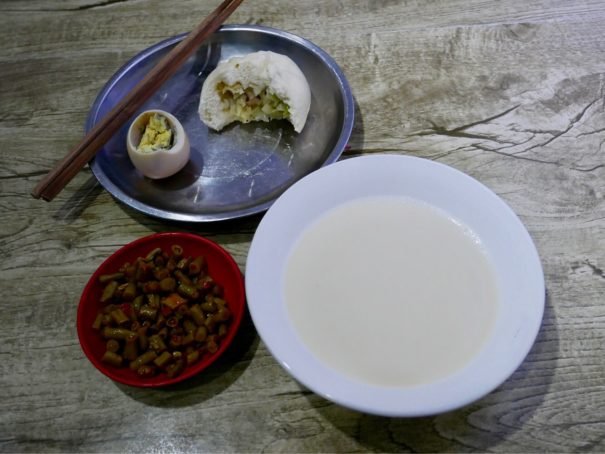
Even Better Than a Hot, Melted, Peanut‑Butter Milkshake

Even Better Than a Hot, Melted, Peanut‑Butter Milkshake
Soy milk in Chengdu
My cure-all for overcast, chilly mornings while living in China and Taiwan has always been hot soy milk. Bean and nut milks are found all over, most often made fresh in the morning. They’re also popular any time of the day in bottled form in Sichuan province, because they soften the numbing heat of local dishes. On the morning after arriving in Chengdu, I set out to find a breakfast spot near my new apartment.
Adjacent to the local car mechanic where one of the neighborhood’s resident street dogs sleeps, I find an eight-seat breakfast spot inviting customers with its giant stack of steamer trays and the smell of soy sauce and star anise wafting from a vat of tea eggs.
The owner, along with her husband and son, churn out fresh soy milk about every 15 minutes. The screeching blender drowns out the blaring TV show playing on another customer’s smartphone and the sound of the grandchildren shrieking with excitement as they dare each other to touch the dog.
Having experimented (and struggled) with homemade soy milk before, I’m surprised to see how quick and straightforward the process is.
The owner fills up a two-liter blender about three-quarters of the way with whole, cooked soybeans, along with a cup of peanuts and a few spoonfuls of sugar. After topping the blender up with leftover water from cooking the beans, she blends it on high for about two minutes. Less of a thin “milk,” the texture looks something akin to heavy cream.
Urban homesteader-types may be familiar with the labor-intensive process of making soy milk and other types of nut and grain milks at home. Soaked soy beans are blended with water, the liquid is strained through fine cheesecloth and then boiled; but low-yield recipes like this are more of a once-a-year endeavor for DIY lifestyle bloggers. The soy milk brands you’ll find in stores employ this technique, but on a much larger scale, with industrial equipment. Family-run breakfast shops that need to produce a lot of the stuff every morning couldn’t feasibly make soy milk this way without pricey machinery and a lot of extra time.
Ayi, or “auntie,” as the owner now asks me to call her, sets a bowl of the thick soy milk on my table, along with a cabbage and mushroom bun, a tea egg, and spicy, pickled green beans. The lard in the bun filling makes an otherwise simple breakfast staple feel decadent, and the egg is perfectly saturated with spices and soy sauce.
But what makes me stop short is the soy milk. More like a hot, melted peanut-butter milkshake, it’s unlike any drink I’ve had. Maybe it’s the peanuts that really surprise me, or simply knowing that the beans had been blended whole. I ask the owner why she makes it this way. “Straining it is too difficult!” she says. “This is how a lot of people make it in small batches. I’d need a much larger blender if I were to do it the standard way.”
It warms me to find such a simple homegrown innovation in preparing something as ubiquitous in China as soy milk. This resourcefulness permits small family-run businesses to maintain Chengdu’s hand-made food culture, while simultaneously creating something unique and delicious.